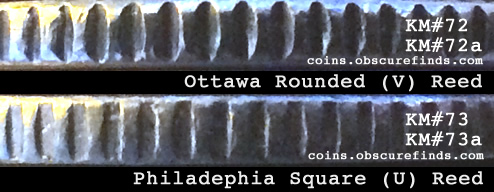1968-1969 - Ottawa Mint (Silver)
Catalog Number: KM#72
Composition: 50% Silver 50% Copper
Coin Mass: 2.33 grams
Magnetic: Non-Magnetic
Edge: Rounded (V) Reeded Edge
Note: Only 6 (1969) Known
REF
The 4 Varieties of the 1968 Canadian Dime
Source: mindlock.me
Two varieties are from the Ottawa Mint and two from the Philadelphia Mint. Determining the mint is done by examining the edge of the coin, if the edge is squared with a U shaped reed, the coin was minted by the Philadelphia Mint. Coins from the Ottawa Mint have a rounded edge with a V shaped reed. The image below shows a visual example of both reeds.
There are two ways to determine if your dime has silver in it:
The first is to use a gram scale, 50% Silver dimes weigh 2.33 grams, 100% Nickel dimes weigh 2.07 grams.
The second is a magnetic test. If the coin sticks to a magnetic it DOES NOT have a silver composition, and is made of 100% nickel. Non-magnetic 1968 Canadian dimes are made of 50% Silver and 50% Copper metal composition. With an Actual Silver Weight (ASW) of 1.165 grams.

1968 - Ottawa Mint
Catalog Number: KM#72a
Composition: 100% Nickel
Coin Mass: 2.07 grams
Magnetic: Magnetic
Edge: Rounded (V) Reeded Edge
1968 - Philadelphia Mint
Catalog Number: KM#73
Composition: 100% Nickel
Coin Mass: 2.07 grams
Magnetic: Magnetic
Edge: Square (U) Reeded Edge
1968-1969 - Ottawa Mint (Silver)
Catalog Number: KM#72
Composition: 50% Silver 50% Copper
Coin Mass: 2.33 grams
Magnetic: Non-Magnetic
Edge: Rounded (V) Reeded Edge
Note: Only 6 (1969) Known
1968 - Philadelphia Mint (Silver)
Catalog Number: KM#73a
Composition: 50% Silver 50% Copper
Coin Mass: 2.33 grams
Magnetic: Non-Magnetic
Edge: Edge: Square (U) Reeded Edge
REF
Dime (Canadian coin)
In Canada, a dime is a coin worth ten cents. It is the smallest (in physical size) of the currently issued Canadian coins. According to the Royal Canadian Mint, the official national term of the coin is the 10 cent piece, but in practice, the term dime predominates in English-speaking Canada. It is nearly identical in size to the American dime, but unlike its counterpart, the Canadian dime is magnetic due to a distinct metal composition: from 1968 to 1999 it was composed entirely of nickel, and since 2000 it has had a high steel content.
Currently the dime has, as with all Canadian coins, a portrait of Her Majesty the Queen on the obverse. The reverse contains a representation of the Bluenose, a famous Canadian schooner. The artist, Emmanuel Hahn, used three ships including the Bluenose as his models, so the ship design is actually a composite.
The word "dime" comes from the French word "dîme", meaning "tithe" or "tenth part", from the Latin decima [pars].
REF
10 Cents - Elizabeth II 2nd portrait, 50% silver
Features
Country Canada
Years 1968-1969
Value 10 Cents
Metal Silver (.500)
Weight 2.33 g
Diameter 18.034 mm
Thickness 1.16 mm
Engravers Arnold Machin (obverse)
Emanuel Hahn (reverse)
Shape Round
Orientation Medal alignment ↑↑
Edge Milled (Ottawa Mint: pointed deep "V"-reeding)
REF

